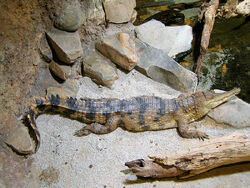No edit summary |
No edit summary |
||
| Line 11: | Line 11: | ||
|statusimage = DD |
|statusimage = DD |
||
|status = Data Deficient}} |
|status = Data Deficient}} |
||
| − | The '''Slender-snouted crocodile''' ('''Mecistops cataphractus'''), is a species of [[Crocodylinae|crocodile]]. Recent studies in DNA and morphology suggest that it may belong in its own genus, '''Mecistops'''. |
+ | The '''Slender-snouted crocodile''' ('''Mecistops cataphractus'''), is a species of [[Crocodylinae|crocodile]]. Recent studies in DNA and morphology suggest that it may belong in its own genus, '''Mecistops'''. |
==Description== |
==Description== |
||
Slender-snouted crocodiles are native to freshwater habitats in central and western [[wikipedia:Africa|Africa]]. They are medium sized crocodiles, typically slightly smaller than the [[Nile Crocodile|Nile crocodile]] (Crocodylus niloticus), but are larger than several other species of [[Crocodilia|crocodilians]]. The adult length is from 3 to 4 m (9.8 to 13.1 ft) and adult weight is from 125–230 kg (276–507 lb). The occasional large specimen can weigh up to 325 kg (717 lb). They have a slender snout used for catching prey, hence their name. |
Slender-snouted crocodiles are native to freshwater habitats in central and western [[wikipedia:Africa|Africa]]. They are medium sized crocodiles, typically slightly smaller than the [[Nile Crocodile|Nile crocodile]] (Crocodylus niloticus), but are larger than several other species of [[Crocodilia|crocodilians]]. The adult length is from 3 to 4 m (9.8 to 13.1 ft) and adult weight is from 125–230 kg (276–507 lb). The occasional large specimen can weigh up to 325 kg (717 lb). They have a slender snout used for catching prey, hence their name. |
||
Revision as of 22:01, 9 November 2014
| Slender-snouted Crocodile | |
|---|---|
 | |
| Information | |
| Range | central and western Africa. |
| Scientific Classification | |
| Kingdom | Animalia |
| Phylum | Chordata |
| Class | Reptilia |
| Order | Crocodylia |
| Family | Crocodylidae Crocodylinae |
| Genus | Mecistops |
| Species | Mecistops cataphractus |
| Conservation Status | |
 Data Deficient | |
The Slender-snouted crocodile (Mecistops cataphractus), is a species of crocodile. Recent studies in DNA and morphology suggest that it may belong in its own genus, Mecistops.
Description
Slender-snouted crocodiles are native to freshwater habitats in central and western Africa. They are medium sized crocodiles, typically slightly smaller than the Nile crocodile (Crocodylus niloticus), but are larger than several other species of crocodilians. The adult length is from 3 to 4 m (9.8 to 13.1 ft) and adult weight is from 125–230 kg (276–507 lb). The occasional large specimen can weigh up to 325 kg (717 lb). They have a slender snout used for catching prey, hence their name.
Behavior
The diet of the slender-snouted crocodile consists mainly of fish, snakes, amphibians and crustaceans. This species is not typically found in groups, except during the onset of the breeding season. The female constructs a mound nest consisting mainly of plant matter. Nests are sited on the banks of rivers, and construction generally begins at the onset of the wet season, although breeding is asynchronous even within members of one population. It has a similar, but generally shorter nesting season than that of the sympatric [[Dwarf Crocodile|dwarf crocodile (Osteolaemus tetraspis), which may nest further from the riverine habitat frequented by Mecistops cataphractus.
The slender-snouted crocodile lays an average of 16 (minimum 13, maximum 27) very large eggs (relative to body size) about a week after completion of the mound nest. The incubation period is long compared with most other crocodilian species, sometimes lasting over 110 days. The female remains close to the nest, but does not defend it with the same vigor as some other species of crocodilians. Once the eggs begin to hatch, and the juveniles emit their characteristic chirping, she will break open the nest and assist in the hatching process. Hatchlings then disperse across the flooded forest floor. Although losses from predators do occur (e.g. by soft-shelled turtles), they apparently are minimal, possibly accounting for the small number of relatively large eggs laid, and the long incubation period. They also have very sharp teeth for protection. It is one of four species of crocodile found in Africa. The others are the Nile, desert and dwarf crocodiles.
Status
This species has not been intensively studied and not enough information is known to provide guidance on its status. It is believed that the population may be dwindling and may be threatened, but whether this is in fact so is unclear. The range is still largely unknown, even where these animals are common. For these reasons, the IUCN has listed this species as "Data Deficient" as it has not been assessed since 1996, at which time it was listed as "Vulnerable".
Taxonomy
Recent genetic and morphological evidence suggests that the slender-snouted crocodile in fact comprises two separate species composed of a central African population (Mecistops cataphractus) and the as yet unnamed west African population. The western species would, in fact, class as one of the most endangered species of crocodilian, and scientists have estimated that the two populations have been separate for 6.5-7.5 million years.
